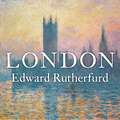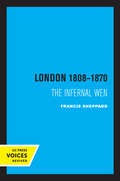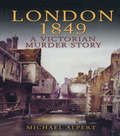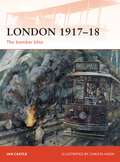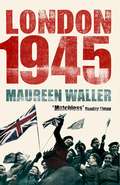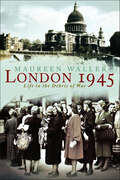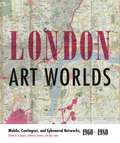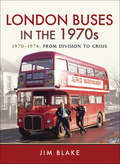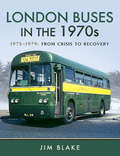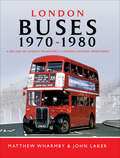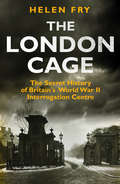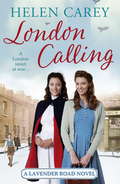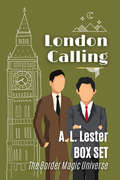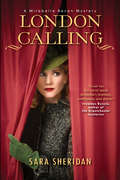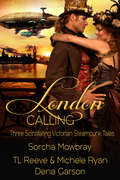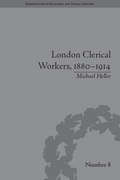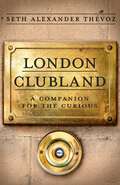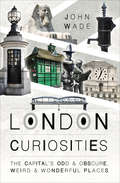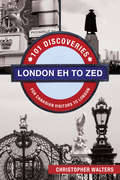- Table View
- List View
London
by Edward RutherfurdA wonderful, epic story that tells the history of the greatest city in the world, from Roman times to the present day from the author of Paris, Sarum and New York.London has perhaps the most remarkable history of any city in the world. Now its story has a unique voice. <p><p>In this epic novel Edward Rutherfurd takes the reader on a magnificent journey across sixteen centuries from the days of the Romans to the Victorian engineers of Tower Bridge and the era dockland development of the modern day. Through the lives and adventures of his colourful cast of characters he brings all the richness of London's past unforgettably to life.(P)2018 Hodder & Stoughton Limited
London
by Robert O. Bucholz Joseph P. WardBetween 1550 and 1750 London became the greatest city in Europe and one of the most vibrant economic and cultural centres in the world. This book is a history of London during this crucial period of its rise to world-wide prominence, during which it dominated the economic, political, social and cultural life of the British Isles, as never before nor since. London incorporates the best recent work in urban history, contemporary accounts from Londoners and tourists, and fictional works featuring the city in order to trace London's rise and explore its role as a harbinger of modernity, while examining how its citizens coped with those achievements. London covers the full range of life in London, from the splendid galleries of Whitehall to the damp and sooty alleyways of the East End. Readers will brave the dangers of plague and fire, witness the spectacles of the Lord Mayor's Pageant and the hangings at Tyburn, and take refreshment in the city's pleasure-gardens, coffee-houses and taverns.
London 1808-1870: The Infernal Wen
by Francis SheppardThis title is part of UC Press's Voices Revived program, which commemorates University of California Press’s mission to seek out and cultivate the brightest minds and give them voice, reach, and impact. Drawing on a backlist dating to 1893, Voices Revived makes high-quality, peer-reviewed scholarship accessible once again using print-on-demand technology. This title was originally published in 1971.
London 1849: A Victorian Murder Story
by Michael AlpertLondon 1849: the city is filthy, plagued, criminal and filling up with refugees from the Irish Famine and the revolutionary wars on the continent...but it is on the brink of reform as stations are built, rioters pardoned and the Great Exhibition planned. The heaving city is the backdrop for the most sensational crime and trial of the decade: the Manning murder case. Throughout the sticky summer the people of London obsessed over the fate of a dominant mysterious woman and her weak husband as the full detail of their slaughter of her lover unfolded. London 1849 follows the murder, trial and execution of the couple, interweaving the scene that was London at the time: crime, noise, cholera, overpacked slums, prostitution, law and order, prisons, fashion, shopping, finance, transport, Marx and Dickens.
London 1917-18
by Christa Hook Ian CastleOsprey's Campaign title for the Gotha and the massive Staaken 'Giant' bomber raids against London during World War I (1914-1918). On a sunny May afternoon in 1917, the peace of an English seaside town was shattered when a flight of German Gotha bombers appeared without warning. Twenty-three Gothas had set out to attack London in this first bomber raid, but heavy cloud forced them to target Folkestone and the Shorncliffe army camp instead. It was the start of a new phase of the war aimed at destroying the morale of the British people. London's defences were quickly overhauled to face this new threat, providing the basis for Britain's defence during World War II.
London 1945
by Maureen WallerLondon at the outset of war in 1939 was the greatest city in the world, the heart of the British Empire. The defiant capital had always been Hitler's prime target and 1945, the last year of the war, saw the final phase of the battle of London. The Civil Defence could not have succeeded without the spirit, courage, resilience and co-operation of the people. London 1945 describes how a great city coped in crisis, how morale was sustained, shelter provided, food and clothing rationed, and work and entertainment carried on. Then, as the joy of VE Day and VJ Day passed into memory, Londoners faced severe shortages and all the problems of post-war adjustment. Women lost the independence the war had lent them, husbands and wives had to learn to live together again, and children had a lot of catching up to do.The year of victory, 1945, represents an important chapter in London's - and Britain's - long history.
London 1945: Life In The Debris Of War
by Maureen WallerLondon at the outset of war in 1939 was the greatest city in the world, the heart of the British Empire. The defiant capital had always been Hitler's prime target and 1945, the last year of the war, saw the final phase of the battle of London. The Civil Defence could not have succeeded without the spirit, courage, resilience and co-operation of the people. London 1945 describes how a great city coped in crisis, how morale was sustained, shelter provided, food and clothing rationed, and work and entertainment carried on. Then, as the joy of VE Day and VJ Day passed into memory, Londoners faced severe shortages and all the problems of post-war adjustment. Women lost the independence the war had lent them, husbands and wives had to learn to live together again, and children had a lot of catching up to do.The year of victory, 1945, represents an important chapter in London's - and Britain's - long history.
London 1945: Life in the Debris of War
by Maureen WallerLondon at the outset of World War II in 1939 was the greatest city in the world, the heart of the British Empire. By 1945, it was a drab and exhausted city, beginning the long haul back to recovery.The defiant capital of England had always been Hitler's prime target. The last months of the Second World War saw the final phase of the battle of London as the enemy unleashed its new vengeance weapons, the flying bombs and rockets. They were terrifying and brought destruction on a vast scale, but fortunately came too late to dent morale seriously.The people of London were showing the spirit, courage, and resilience that had earned them the admiration of the world during a long siege. In the harshest winter of fifty years, they were living in primitive conditions. Thousands were homeless, living in the Underground and deep shelters. Women lined up for horse meat and were lucky to obtain one egg a month. They besieged emergency coal dumps. Everyone longed for peace.The bright new world seemed elusive. As the victory celebrations passed into memory, there were severe hardships and all the problems of post-war adjustment. Women lost the independence the war had lent them, husbands and wives had to learn to live together again, and children had a lot of catching up to do.Yet London's loss has often been its opportunity. Its people had eagerly embraced plans for a modern metropolis and an end to poverty. They voted overwhelmingly for a Labour government and the new, fairer social order that was their reward for all they had endured.The year of victory, 1945, represents an important chapter in London's---and Britain's---long history. Acclaimed historian Maureen Waller draws on a rich array of primary sources, letting the people tell their own story, to re-create that moment, bringing to it the social insight at which she excels.
London Art Worlds: Mobile, Contingent, and Ephemeral Networks, 1960–1980 (Refiguring Modernism #24)
by Catherine Spencer Jo Applin Amy TobinThe essays in this collection explore the extraordinarily rich networks of international artists and art practices that emerged in and around London during the 1960s and ’70s, a period that saw an explosion of new media and fresh attitudes and approaches to making and thinking about art.The contributors to London Art Worlds examine the many activities and movements that existed alongside more established institutions in this period, from the rise of cybernetics and the founding of alternative publications to the public protests and new pedagogical models in London’s art schools. The essays explore how international artists and the rise of alternative venues, publications, and exhibitions, along with a growing mobilization of artists around political and cultural issues ranging from feminism to democracy, pushed the boundaries of the London art scene beyond the West End’s familiar galleries and posed a radical challenge to established modes of making and understanding art.Engaging, wide-ranging, and original, London Art Worlds provides a necessary perspective on the visual culture of the London art scene in the 1960s and ’70s. Art historians and scholars of the era will find these essays especially valuable and thought provoking.In addition to the editors, contributors to this volume are Elena Crippa, Antony Hudek, Dominic Johnson, Carmen Juliá, Courtney J. Martin, Lucy Reynolds, Joy Sleeman, Isobel Whitelegg, and Andrew Wilson.
London Art Worlds: Mobile, Contingent, and Ephemeral Networks, 1960–1980 (Refiguring Modernism)
by Catherine Spencer Jo Applin Amy TobinThe essays in this collection explore the extraordinarily rich networks of international artists and art practices that emerged in and around London during the 1960s and ’70s, a period that saw an explosion of new media and fresh attitudes and approaches to making and thinking about art.The contributors to London Art Worlds examine the many activities and movements that existed alongside more established institutions in this period, from the rise of cybernetics and the founding of alternative publications to the public protests and new pedagogical models in London’s art schools. The essays explore how international artists and the rise of alternative venues, publications, and exhibitions, along with a growing mobilization of artists around political and cultural issues ranging from feminism to democracy, pushed the boundaries of the London art scene beyond the West End’s familiar galleries and posed a radical challenge to established modes of making and understanding art.Engaging, wide-ranging, and original, London Art Worlds provides a necessary perspective on the visual culture of the London art scene in the 1960s and ’70s. Art historians and scholars of the era will find these essays especially valuable and thought provoking.In addition to the editors, contributors to this volume are Elena Crippa, Antony Hudek, Dominic Johnson, Carmen Juliá, Courtney J. Martin, Lucy Reynolds, Joy Sleeman, Isobel Whitelegg, and Andrew Wilson.
London Buses in the 1970s, 1970–1974: From Division to Crisis
by Jim BlakeUsing photographs from Jim Blake's extensive archives, this book examines the turbulent period in the history of London's buses immediately after London Transport lost its Country Buses and Green Line Coaches to the recently-formed National Bus Company, under their new subsidiary company, London Country Bus Services Ltd.The new entity inherited a largely elderly fleet of buses from London Transport, notably almost 500 RT-class AEC Regent double-deckers, of which replacement was already under way in the shape of new AEC MB and SM class Swift single-deckers.London Transport itself was in the throes of replacing a much larger fleet of these. At the time of the split, it was already apparent that the 36ft-long MB class single-deckers were not suitable for London conditions, particularly in negotiating suburban streets cluttered with cars, and were also mechanically unreliable. The shorter SM class superseded them but they were equally unreliable. January 1971 saw the appearance of London Transport's first purpose-built one-man operated double-decker, the DMS class. All manner of problems plagued these, too.Both operators were also plagued with a shortage of spare parts for their vehicles, made worse by the three-day week imposed by the Heath regime in 1973-4. London Transport and London Country were still closely related, with the latter's buses continuing to be overhauled at LT's Aldenham Works. Such were the problems with the MB, SM, and DMS types that LT not only had to resurrect elderly RTs to keep services going, but even repurchased some from London Country! In turn, the latter operator hired a number of MB-types from LT, now abandoned as useless, from 1974 onwards in an effort to cover their own vehicle shortages. Things looked bleak for both operators in the mid-1970s.This book contains a variety of interesting and often unusual photographs illustrating all of this, most of which have never been published before.
London Buses in the 1970s: 1975–1979: From Crisis to Recovery
by Jim Blake&“A compilation of photos taken in the difficult period . . . when LT and London Country were plagued with maintenance problems. A valuable record.&” —West Somerset Railway Association Continuing with images from transport photographer Jim Blake&’s extensive archives, this book examines the second half of the 1970s, when both London Transport and London Country were still struggling to keep services going. This resulted both from being plagued by a shortage of spare parts for their vehicles and having a number of vehicle types which were unreliable—the MB, SM and DMS classes. In 1975, both operators had to hire buses from other companies, so desperate were they. Many came from the seaside towns of Southend, Bournemouth and Eastbourne. This continued until the spares shortage began to abate later in the decade, particularly with London Country. As the decade progressed, the two fleets began to lose their &“ancestral&” vehicle types. London Country rapidly became &“just another National Bus Company fleet,&” buying Leyland Atlanteans and Nationals common to most others throughout the country. Having virtually abandoned the awful MB and SM-types, London Transport had to suffer buying the equally awful DMSs well into 1978, but had already ordered replacements for them by that point—the M class Metrobuses and T class Titans—both of which would finally prove successful. However, plans to convert trunk routes serving Central London to one-person operation were largely abandoned. &“A very interesting book. The passenger transport crisis in London in the mid-1970s was a major event.&” —Miniaturas JM
London Buses, 1970–1980: A Decade of London Transport and London Country Operations
by Matthew WharmbyThe 1970s were among London Transports most troubled years. Prohibited from designing its own buses for the gruelling conditions of the capital, LT was compelled to embark upon mass orders for the broadly standard products of national manufacturers, which for one reason or another proved to be disastrous failures in the capital and were disposed of prematurely at a great loss. Despite a continuing spares shortage combined with industrial action, the old organisation kept going somehow, with the venerable RT and Routemaster families still at the forefront of operations.At the same time, the green buses of the Country Area were taken over by the National Bus Company as London Country Bus Services. Little by little, and not without problems of their own, the mostly elderly but standard inherited buses gave way to a variety of diverted orders, some successful others far from so, until by the end of the decade we could see a mostly NBC-standard fleet of one-man-operated buses in corporate leaf green.
London Cage: The Secret History of Britain's World War II Interrogation Centre
by Helen FryThe first complete account of the fiercely guarded secrets of London’s clandestine interrogation center, operated by the British Secret Service from 1940 to 1948 Behind the locked doors of three mansions in London’s exclusive Kensington Palace Gardens neighborhood, the British Secret Service established a highly secret prison in 1940: the London Cage. Here recalcitrant German prisoners of war were subjected to “special intelligence treatment.” The stakes were high: the war’s outcome could hinge on obtaining information German prisoners were determined to withhold. After the war, high-ranking Nazi war criminals were housed in the Cage, revamped as an important center for investigating German war crimes. This riveting book reveals the full details of operations at the London Cage and subsequent efforts to hide them. Helen Fry’s extraordinary original research uncovers the grim picture of prisoners’ daily lives and of systemic Soviet-style mistreatment. The author also provides sensational evidence to counter official denials concerning the use of “truth drugs” and “enhanced interrogation” techniques. Bringing dark secrets to light, this groundbreaking book at last provides an objective and complete history of the London Cage.
London Calling
by Helen CareyLONDON CALLING is a poignant, warm-hearted and engaging saga of Clapham, south London's women during the Second World War, for readers of Kate Thompson, Annie Murray and Katie Flynn. It will take more than Hitler's Luftwaffe to break the spirit of the residents of Lavender Road. If courage and resilience could win wars, the conflict would already be over.It's not all harmony, though. Nurse Molly Coogan and would-be actress Jen Carter certainly don't see eye to eye. Molly, despite hating the discipline of wartime hospital life, is unimpressed by Jen's prima donna ways. Jen, unaware of Molly's secret heartache, can't resist taking her own frustrations out on Molly. It's just as well that no one knows what challenges lie ahead...From stolen glasses in the Flag and Garter to fancy dinners in the heart of the West End, from a desperate battle for survival on a hospital ward to a torpedo hitting its target in the Mediterranean Sea, LONDON CALLING takes readers into a world of ordinary people living extraordinary lives.
London Calling
by Helen CareyLONDON CALLING is a poignant, warm-hearted and engaging saga of Clapham, south London's women during the Second World War, for readers of Kate Thompson, Annie Murray and Katie Flynn. It will take more than Hitler's Luftwaffe to break the spirit of the residents of Lavender Road. If courage and resilience could win wars, the conflict would already be over.It's not all harmony, though. Nurse Molly Coogan and would-be actress Jen Carter certainly don't see eye to eye. Molly, despite hating the discipline of wartime hospital life, is unimpressed by Jen's prima donna ways. Jen, unaware of Molly's secret heartache, can't resist taking her own frustrations out on Molly. It's just as well that no one knows what challenges lie ahead...From stolen glasses in the Flag and Garter to fancy dinners in the heart of the West End, from a desperate battle for survival on a hospital ward to a torpedo hitting its target in the Mediterranean Sea, LONDON CALLING takes readers into a world of ordinary people living extraordinary lives.
London Calling Box Set
by A. L. LesterQueer British Lovecraftian historical romantic suspense set in 1920s London.Lew Tyler is dragged from 2016 to 1920 by an accident with border magic whilst he’s searching for his missing friend. He’s struggling to get to grips with life a century before he was born. Detective Alec Carter is trying to solve gruesome murders in his patch of London, weighed down with exhaustion and a jaded attitude to most of his fellow humans after four years of war. In the middle of a murder investigation that involves wild magic, mysterious creatures and illegal sexual desire, will Alec and Lew work out who is safe to trust?Sergeant Will Grant, Alec’s right-hand man, is drawn to the mysterious Fenn. Is Fenn a man or a woman? Does Will care? And Fenn ... Fenn has a secret. They live beyond the border between 1920s London and the magical Outlands and they need to get home. Are they prepared to achieve that by double crossing Alec, Will, and Lew?Two couples hold the fabric of reality in their hands. Will it make them or break them? Contains the stories:Lost in Time: Gruesome murders taking place across 1920s London draw Lew and Alec together through the desolation of the East End and the smoky music clubs of Soho. They both have secrets that could get them arrested or killed. In the middle of a murder investigation that involves wild magic, mysterious creatures and illegal sexual desire, who is safe to trust?Shadows on the Border: In 1920s London, Lew and his lover Detective Alec Carter are working out the parameters of their new relationship. Lew is torn between staying in the past and trying to get back to 2016. Alec is wrestling with the idea both of being in love and Lew being a magician. Meanwhile Alec’s sergeant, Will Grant, is drawn to the mysterious Fenn, a hunter from the Outlands.The Hunted and the Hind: Inadvertently tumbling through the border after Fenn, Sergeant Will Grant of the Metropolitan Police has spent three months in prison. When Fenn frees him, they step through the border to the Egyptian desert. It’s a two week trip back to England, with the possibility of pursuit. Will the journey give Fenn and Will time to resolve the feelings they have been dancing around since the day they met?
London Calling: A Mirabelle Bevan Mystery (A Mirabelle Bevan Mystery #2)
by Sara SheridanIn the years following World War II, former Secret Service employee Mirabelle Bevan has found a refuge in the quiet coastal town of Brighton. But she can’t seem to resist an attraction to danger and a thirst for justice . . .1952: Eighteen-year-old debutante Rose Bellamy Gore was last seen outside a Soho jazz club in the company of a saxophone player named Lindon Claremont. Now her mysterious disappearance is front-page news in the London tabloids.When Lindon turns up the next day in Brighton, desperately seeking help, Mirabelle counsels him to cooperate with the authorities. After the local police take the musician into custody and ship him off to Scotland Yard, Mirabelle and her best friend, Vesta Churchill, hop a train to London in search of the truth.As they scour smoky jazz clubs searching for clues to the deb’s disappearance, they descend into a sinister underworld where the price of admission can be one’s life. Mirabelle will need to draw on her espionage skills to improvise her way out of a disappearing act of her own . . .Praise for the first Mirabelle Bevan mystery, Brighton Belle“Beneath that prim exterior lies a fearless, fly-by-the-seat-of-her-pants kind of gal. One part Nancy Drew, two parts Jessica Fletcher, Mirabelle has a dogged tenacity to rival Poirot.” —Sunday Herald“Unfailingly stylish, undeniably smart.” —Daily Record“I was gripped from start to finish.” —Newbooks“Fresh, exciting, and darkly plotted, this sharp historical mystery plunges the reader into a shadowy and forgotten past.” —Good Book Guide“Early 1950s England is effectively portrayed in this intriguing mystery story . . . An excellent read for the beach or a long flight.” —Historical Novel Review“After many twists and turns, she finally unravels the mystery in an entertaining romp pitting her wits against underworld characters and scheming impostors.” —Bookseller“An entertaining mystery read—light, intriguing and ideal for a weekend escape. Bits of history enhance the plot without overwhelming it, and a handful of unexpected twists keep the reader guessing.” —RT Book Reviews
London Calling: Three Scintillating Victorian Steampunk Tales
by Tl Reeve Michele Ryan Sorcha Mowbray Dena GarsonJourney to Victorian London where an assassin meets her match, zombies invade, and top scientists go missing.Four talented authors come together to bring you three BRAND NEW, full length Victorian steampunk novels of seduction, adventure, and mystery. A look inside…Seducing the Assassin (Book 1, The Ladies League)by Sorcha MowbrayJosephine Stanton, Madame and assassin, has another assignment to eliminate an enemy of the Queen. Too bad John Griffin, The Earl of Melton, has no intention of dying. Neither of the pair expects the heat that steams them up between the sheets and ultimately sets New Victorian London on its ear. Darkness Rises by TL Reeve and Michele RyanA zombie horde has invaded London, England. Jonah McRae and his band of ghoulish Dreadfuls are London’s only hope. However, when Annabelle Craig threatens his mission he doesn’t know whether to kill her or claim her as his. Can the hunter and the huntee team together to take down the horde? Or will London be lost forever? Her Clockwork Heart by Dena GarsonDuring her search for her missing brother, Trixie is reunited with Nathaniel, the man she never stopped loving. Sensing that Trixie might be in danger, Nathaniel lends his skills as an investigator to her efforts. Their love is rekindled as they race across the country looking for clues to more than one mystery.
London Clerical Workers, 1880–1914: Development of the Labour Market (Perspectives in Economic and Social History #8)
by Michael HellerThis study is based on a wide range of business sources as well as newspapers, journals, novels and oral history, allowing Heller to put forward a new interpretation of working conditions for London clerks, highlighting the ways in which clerical work changed and modernized over this period.
London Clubland: A Companion for the Curious
by Seth Alexander ThévozStep into the hidden world of London's private members' clubs with London Clubland: A Companion for the Curious. This guide, by the leading historian on the subject, offers a fascinating insight into these legendary institutions. Culture, history and traditions are all explained - from aristocratic haunts like Boodle's and Brooks's, to modern icons like Soho House and the Groucho Club.Insightful and entertaining, London Clubland is your ultimate guide and almanac to this world, from navigating the application process, to the unwritten rules that define these spaces - not to mention a wealth of trivia assembled over twenty years. Readers will discover mottos, maps, songs and club recipes, as well as little-known facts that some of London's most iconic clubs probably wouldn't want you to know.Whether you are a long-standing member, a reciprocal visitor, an aspiring applicant, or simply just curious about this secretive world, London Clubland offers an engaging and revealing tour through some of London's most discreet institutions.
London Clubland: A Companion for the Curious
by Seth Alexander ThévozStep into the hidden world of London's private members' clubs with London Clubland: A Companion for the Curious. This guide, by the leading historian on the subject, offers a fascinating insight into these legendary institutions. Culture, history and traditions are all explained - from aristocratic haunts like Boodle's and Brooks's, to modern icons like Soho House and the Groucho Club.Insightful and entertaining, London Clubland is your ultimate guide and almanac to this world, from navigating the application process, to the unwritten rules that define these spaces - not to mention a wealth of trivia assembled over twenty years. Readers will discover mottos, maps, songs and club recipes, as well as little-known facts that some of London's most iconic clubs probably wouldn't want you to know.Whether you are a long-standing member, a reciprocal visitor, an aspiring applicant, or simply just curious about this secretive world, London Clubland offers an engaging and revealing tour through some of London's most discreet institutions.
London Curiosities: The Capital's Odd & Obscure, Weird & Wonderful Places
by John WadeLondon is full of curiosities. Who knew that beneath the Albert Memorial lies a chamber resembling a church crypt? Or that there are catacombs under Camden? Who would expect to find a lighthouse in East London, sphinxes in South London, dummy houses in West London, or a huge bust of film director Alfred Hitchcock in North London? <p><p> How many of those who walk past Cleopatra’s Needle pause to consider why a 3,000-year-old Egyptian monument stands beside the Thames? How many know that what was once London’s smallest police station can be seen in Trafalgar Square? Or that pineapples are used in the architectural design of so many buildings? Or why there are memorials to the Mayflower and Pilgrim Fathers in Rotherhithe? Learn more about the capital of curiosities in this delightful guide for lovers of history, trivia, and travel.
London Eh to Zed: 101 Discoveries for Canadian Visitors to London
by Christopher WaltersDiscover London — and Canada — in one guidebook! Thousands of Canadians visit London, England, every year. But what their popular guidebooks always fail to mention are the over one hundred objects, monuments, and locations in the city associated with their own home and native land. Take for example the statue of half-mad General Charles Gordon standing beside the River Thames. His capture by rebels set in motion a dramatic rescue attempt that became Canada's first overseas military mission. Then there's the world's most famous suffragette Emmeline Pankhurst. Do Canadians know she marched on syphilis in Canada after winning the vote for women in Britain? Or that a cross-eyed doctor from McGill University in Montreal became London's most notorious serial killer after Jack the Ripper? London Eh to Zed is a light-hearted and entertaining walking guide especially for Canadians. Exploring seven neighbourhoods in London, it uncovers 101 fun discoveries about our history, character, passions, and foibles. Along streets in St. James's, Greenwich, and elsewhere, readers will meet men and women like the doomed adventurer Sir John Franklin, the un-amused Queen Victoria, and the tennis-loving but luckless Prince Rupert, first governor of the Hudson's Bay Company, who never collected any HBC Rewards.
London Fog: The Biography
by Christine L. CortonThe classic London fogs--thick yellow "pea-soupers"--were born in the industrial age and remained a feature of cold, windless winter days until clean air legislation in the 1960s. Christine L. Corton tells the story of these epic London fogs, their dangers and beauty, and the lasting effects on our culture and imagination of these urban spectacles.
